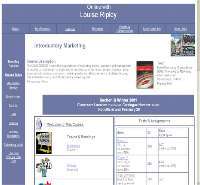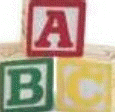Online Course Kits
Whether you are taking a course on the Internet with me or an on-campus class,
my course kits are now online. I can get them to you much faster this way.
This is all there is - there is no course kit to buy in the bookstore and
nothing handed out in class. This page will help you get to know the website.
 |
My site is very much a “web” – everything
branches out from the Course Syllabus, everything is connected to everything else
(the basic premise of my Great Books Liberal Arts undergraduate education), and
everything is as consistent as I can manage to get it. All my web pages were
designed by the same person – me, so look for consistencies in design that
will help you figure out where you are. All pages relating specifically
to one course for example have the same coloured stripe across the top
and left. I use no password protection so you can get in at any time,
even after you have completed the course. |
| The Course
Syllabus Each course I teach starts on the
"Course Syllabus" page and to get there you enter either through
the official Course Outline or through my website.
Everything is on the Course
Syllabus page
or linked to it. |
 |
 |
A basic building block of the web is the
link. It’s what differentiates a website from traditional published
material. In a book the author writes, “refer to page 118” and figures
the reader will find the right place on that page. On the web, we just put
in a “hyperlink” (usually blue but not always, usually underlined
but not always) and the reader clicks on it and goes where she's
supposed to go. Sometimes a picture illustrating a link is also a link
itself. If you run the mouse over a link, a hand with a pointing
index finger will appear. |
I assume you read the Course Syllabus. It's
full of all kinds of information that will make your learning experience with me
easier. Although you are
welcome to print out anything you wish, do not fall into the trap of thinking in
the old-fashioned mode of traditional print materials and just print all this stuff
out and expect it to stay static. The whole point of Internet materials is that
they can easily and quickly be changed. Important things like an assignment due
date or the weight of a test won't change, but you might, for example, be
provided with clearer instructions on an upcoming assignment, or have material
added to a section after a student has written to say they'd like it clearer. This corresponds
to the experience in class when a student asks me at break about something that
isn't clear in the course kit, and as soon as we start class, I make a general
announcement to everyone to make it clearer.
Test dates, due dates, times,
texts, readings, method of delivery, are all on the Course Syllabus page.
There is a link to instructions for the Discussion Group, and a
note that tells you that you must have a YorkU.ca email account to
participate in an Internet course. Even in on-campus courses, I use
your yu# account to contact you and if you don't have one, you won't
hear from me. There are also links to pages that tell you how to do your assignments and
what I expect, what tests are likely to be like, what you'll need to
do well in the course, where and when to find me.
| There are links on nearly all pages that will take you to
other pages that
tell you more about me as your professor - my Research, Service, and
Teaching, a list of other important links, and a
Personal page -- all with information that I'd probably share with you
in one way or another in a traditional classroom. I come out of a
feminist pedagogy which insists that it matters who is teaching you.
|
If reading materials are provided
online, there are links to them
from the course syllabus. If I refer to a company's mission statement
in an Intro Marketing class, I may provide a link to the company's
website where they list their mission statement. If there's a film to be viewed,
instructions are linked from there, usually on the
"Assignments" page. It's all there, including all the
"small print" that reminds you of all the things you are
responsible for.
To get back to the Course Syllabus at any
time, click on
your browser's back button. I
can't show you where this one is; it will be a little different on each system.
Mine is in the upper left corner of my computer screen. Alternatively, you can
go to the top of the page where you will find a link called "Return to Course
Syllabus.
 |
Down the sides of many of the pages are
links to Policy Pages which form an integral part of all course
kits. Read through the Ground
Rules first. Try
not to be overwhelmed by the amount of information available to you. If
you're in an Internet course, you won't have me in class, and everything I normally do has to be provided
here instead. Don't read it all in detail; skim it, bookmark it, know
where to go for information when you need it.
To start most Internet courses, just start reading the
textbook and working your way through the units provided online.
|
 |
The
Small Print
There are many links and sites on my web pages that will
tell you about York, the Faculty, me, and how I teach. You
are welcome to check these out. You MUST check any
Teaching Policy links; they
are an integral
part of the course and you are responsible for their
content. |
The Biggest problem you’re most likely going to have
is not reading
the Course Syllabus page carefully. Go back to it regularly; bookmark it so you
can get right to it. Check it often and refer to it for everything.
Testing the Web
Routes I’ve tested all this stuff out
on my web expert using the most advanced sophisticated
technical methods available today -- usually a holler across the room, “Hey
you! Go look at my Intro Marketing Assignments page!” and if the web
expert (my husband) can’t find it, I know I have to make it easier to get
there and I do. But that said, we all have different bugaboos that
cause us trouble; here are some of the most common errors.
Web
Errors
(most, sad to admit, I have done myself) |
| Error |
Solution |
| Not Reading
Instructions
|
Read the
Instructions
I hate wasting my precious time reading instructions, I want
to get right into whatever I’m doing, but for most things in
life, we have to read some sort of instructions if we expect
to be successful. |
| Forgetting The
“Back” Key
|
Find
your browser's “back” key and use it,
regularly. It will take you back to the page you were
just on. |
Making It Too
Complicated
The instant
anything, no matter how small and seemingly insignificant goes
wrong, I assume that the entirety of the world wide network of
computer machinery and expertise has suddenly and inexplicably
collapsed forever and no one will ever again be able to use
it. In reality it’s more likely that I
hit the number lock key while typing, or knocked the monitor
cable out while dusting. While I'm
envisioning the collapse of civilization as we know it, my
husband finds the Number Lock light and the loose cable.
|
Look For a Simple
Solution First
Check that things are
as they should be; double check that you're doing what you think you're
doing |
| Forgetting
about the Refresh/Reload Button |
 |
The screen looks strange, the professor said
she’s posted something new but it’s the same old page, a
link won’t work, a picture is fuzzy… |
Hit the
Refresh or Reload Button
Any time something doesn’t work on your computer
(assuming it’s plugged in and working normally), try the
“refresh” key. If you're still having problems, try
hitting the F5 Key. |
| Assuming the Back
Key is Forever
|
If you’ve been backing up and
backing up and suddenly find yourself in the poppy fields of
Oz miles away from the yellow brick road, go back to the
course syllabus (often a direct link at top of the page you're
on), go “home”
(button on every page) where you'll find a search
engine for the web page, or go to the
Index where you can look up where you want to go, and
start over. Wherever I can, I put a button such as "Go Back to
(a specific place)" but on pages to which dozens of other pages
link, it's not always possible |
General Advice Stay calm, don't panic (civilization usually does
NOT end in an afternoon). Try to figure it out logically because I'm a
very logical person and there is logic in (almost) everything on my web. Ask for help from a group member or classmate
you've met on the web. Write the helpdesk@yorku.ca
or esohelp@yorku.ca if it's a
technical problem. If you find an
error let me know and I'll fix it; I never clammed to be prefect.
|